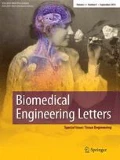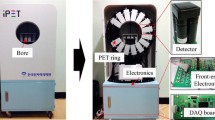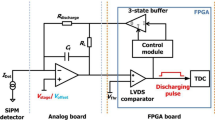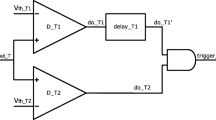Abstract
Purpose
A coincidence detector is an essential unit to acquire distribution of radioisotopes in positron emission tomography (PET) systems. The coincidence pairs rapidly increase as the number of detector modules increase. To make this system compact, flexible, and conveniently controllable, a field programmable gated array (FPGA)-based coincidence detector was developed.
Methods
The unit targeted PET systems have eight detector modules. The coincidence detector module needs veto function for controlling the data transfer rate of the output signal because the output is connected to the band-limited ADC and data transfer unit. The coincidence detector module has eight inputs connected to the detector modules, one coincidence output signal connected to the trigger input of the ADC, and three control signals for setting system parameters, such as the coincidence window time, output pulse length, and veto time.
Results
The performance of the unit was restricted by system clock frequency. The maximum clock frequency was 250 MHz when the unit was implemented to XILINX Spartan 3 FPGA. The unit had a minimum 2 ns of coincidence timing window when it runs in the double data rate (DDR) mode. The unit was also applied to PET image acquisition and the PET/CT and PET/MR images were successfully acquired.
Conclusions
The coincidence unit developed in this study was useful for PET image acquisition with PMT- and SiPM-based PET prototypes. The unit can be easily extended to larger systems that have many more detector modules without extra components.
Similar content being viewed by others
References
Shibata H, Nomori H, Uno K, Sakaguchi K, Nakashima R, Iyama K, Tomiyoshi K, Kaji M, Goya T, Suzuki T, Horio H. 18F-fluorodeoxyglucose and 11C-acetate positron emission tomography are useful modalities for diagnosing the histologic type of thymoma. Cancer. 2009; 115:2531–2538.
Wahl RL, Jacene H, Kasamon Y, Lodge MA. From RECIST to PERCIST: evolving considerations for PET response criteria in solid tumors. J Nucl Med. 2009; 50:122S–150S.
Kim JY, Kim HO, Kim JS, Moon DH, Kim YH, Kim DK, Park SI, Park YS, Ryu JS. 18F-FDG PET/CT is useful for pretreatment assessment of the histopathologic type of thymic epithelial tumors. Nucl Med Mol Imaging. 2010; 44:177–184.
Min JJ, Nguyen VH, Gambhir SS. Molecular imaging of biological gene delivery vehicles for targeted cancer therapy: beyond viral vectors. Nucl Med Mol Imaging. 2010; 44:15–24.
Cherry SR, Sorenson JA, Phelps ME. Physics in nuclear medicine. 3rd ed. Philadelphia: Elsevier Science; 2003.
Vale PE, Bailey DL, Townsend DW, Maisey MN. Positron emission tomography, basic science and clinical practice. London: Springer; 2003.
Hong SJ, Kwon SI, Ito M, Lee GS, Sim KS, Park KS, Rhee JT, Lee JS. Concept verification of three-layer DOI detectors for small animal PET. IEEE T Nucl Sci. 2008; 55(3):912–917.
Ito M, Lee JS, Park MJ, Sim KS, Hong SJ. Design and simulation of a novel method for determining depth-of-interaction in a PET scintillation crystal array using a single-ended readout by a multi-anode PMT. Phys Med Biol. 2010; 55(13):3827–3841.
Lee JS, Hong SJ. Geiger-mode avalanche photodiodes for PET/ MRI. In: Iniewski K, editor. Electronic circuits for radiation detection. Boca Raton: CRC Press LLC; 2010. pp. 179–200.
Yoon HS, Lee CM, Ito M, Kwon SI, Kim SM, Ko GB, Lee DS, Hong SJ, Lee JS. Breast-dedicated positron emission tomography systems. J Biomed Eng Res. 2010; 31:259–268.
Hong SJ, Kim CM, Cho SM, Woo H, Ko GB, Kwon SI, Rhee JT, Song IC, Lee JS. A feasibility study on the use of optical fibers for the transfer of scintillation light to silicon photomultipliers. IEEE T Nucl Sci. [In press].
Kwon SI, Lee JS, Yoon HS, Ito M, Ko GB, Choi JY, Lee SH, Song IC, Jeong JM, Lee DS, Hong SJ. Development of small animal pet prototype using silicon photomultiplier (SiPM): initial results of phantom and animal imaging studies. J Nucl Med. [In press].
Ito M, Hong SJ, Lee JS. Positron emission tomography (PET) detectors with depth-of-interaction (DOI) capability. Biomed Eng Lett. [In press].
Lee JS, Park KS, Lee DS, Lee CW, Chung JK, Lee MC. Development and applications of a software for functional image registration (FIRE). Comput Meth Prog Bio. 2005; 78(2):157–164.
Author information
Authors and Affiliations
Corresponding author
Rights and permissions
About this article
Cite this article
Ko, G.B., Yoon, H.S., Kwon, S.I. et al. Development of FPGA-based coincidence units with veto function. Biomed. Eng. Lett. 1, 27–31 (2011). https://doi.org/10.1007/s13534-011-0001-3
Received:
Accepted:
Published:
Issue Date:
DOI: https://doi.org/10.1007/s13534-011-0001-3




